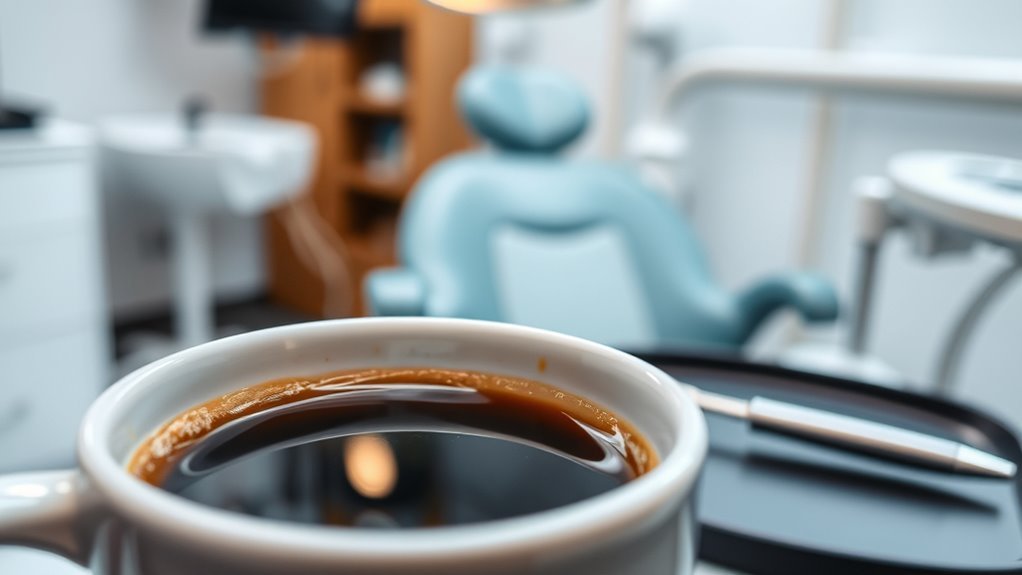Can You Drink Coffee After a Filling
After getting a dental filling, you should wait at least 24 hours before drinking coffee. This time allows the filling material to set properly and helps minimize discomfort. Hot coffee can irritate sensitive areas in your mouth, so consider starting with lukewarm coffee. It’s important to monitor for any unusual sensitivity or pain, as these could indicate complications. Learn more about ensuring a smooth recovery and enjoying your coffee safely after your dental procedure.
Understanding Dental Fillings
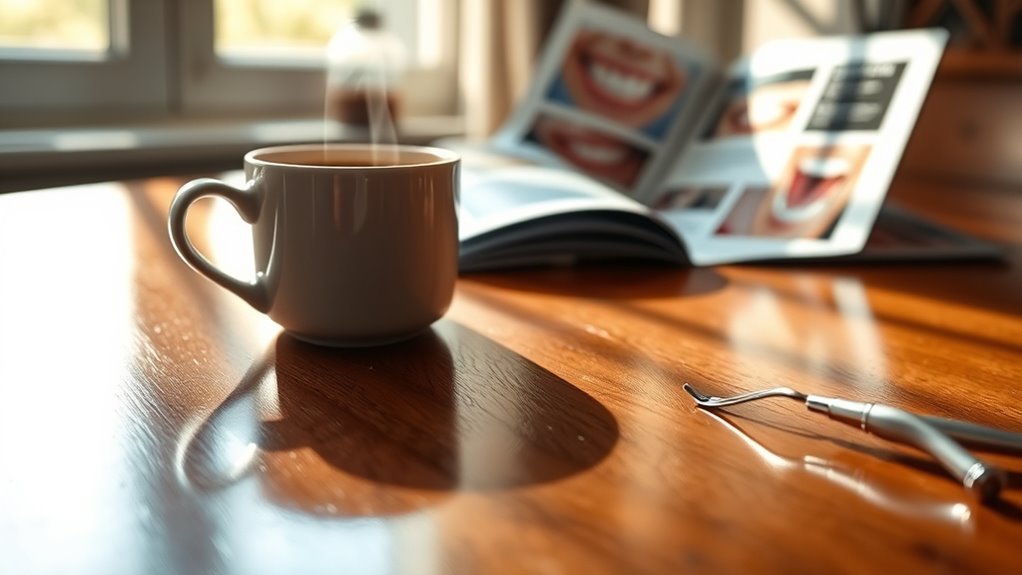
When you get a dental filling, it’s vital to understand what’s happening in your mouth. A filling is used to restore a tooth damaged by decay, making sure it functions properly. Your dentist removes the decayed material and fills the cavity with a durable substance, like composite resin or amalgam. Proper dental hygiene is essential after getting a filling; maintaining a routine of brushing and flossing helps prevent further decay. Additionally, filling maintenance involves regular dental check-ups to guarantee the filling remains intact and effective. You’ll want to be mindful of your diet, as certain foods can affect the longevity of the filling. By prioritizing these practices, you empower yourself to enjoy a healthier, pain-free smile.
Immediate Aftercare Following a Filling
After receiving a dental filling, immediate aftercare plays a significant role in your recovery and the longevity of the filling. Proper dental care right after the filling procedure can help prevent complications and guarantee a smooth healing process. Here’s what you should keep in mind:
Immediate aftercare following a dental filling is crucial for recovery and ensuring the filling lasts effectively.
- Avoid hard or sticky foods for at least 24 hours to protect the filling.
- Don’t chew on the side of the mouth where the filling is located until the numbness wears off.
- Maintain good oral hygiene, but be gentle when brushing around the filled area.
Types of Fillings and Their Properties
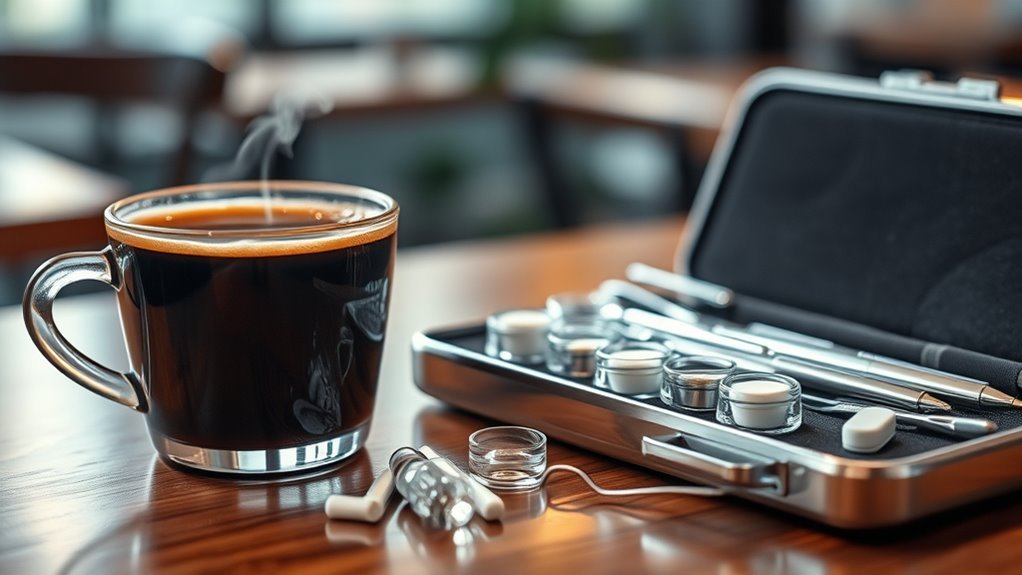
When considering dental fillings, it’s important to know the different types and their properties. Amalgam fillings are durable and cost-effective, while composite resins offer aesthetic appeal and versatility. Glass ionomer fillings provide unique benefits, such as fluoride release, which can help with cavity prevention.
Amalgam Fillings Overview
Amalgam fillings, a commonly used dental restoration material, are composed of a mixture of metals, primarily silver, mercury, tin, and copper. This amalgam composition provides significant advantages for dental work, particularly regarding filling durability. Here are some key characteristics:
- Strength: Amalgam is highly durable and can withstand the pressure of chewing.
- Longevity: These fillings typically last 10 to 15 years or longer with proper care.
- Cost-Effectiveness: Amalgam fillings are often more affordable than their alternatives.
Understanding these properties can help you make informed decisions about your dental care. If you have concerns about your fillings, always consult your dentist for personalized advice.
Composite Resin Characteristics
Composite resin fillings offer a different set of characteristics compared to amalgam fillings. These fillings are known for their excellent aesthetic appeal, blending seamlessly with your natural tooth color. This makes them a popular choice for visible areas in your mouth. With respect to composite durability, these fillings are designed to withstand normal chewing forces, though they may not be as strong as amalgam in high-stress zones. However, advancements in dental materials have greatly improved their longevity and resistance to wear. Additionally, composite resins bond chemically to the tooth structure, providing added strength and reducing the risk of further decay. Ultimately, choosing composite fillings means you’re prioritizing both function and appearance, giving you the freedom to smile confidently.
Glass Ionomer Benefits
Glass ionomer fillings present a unique blend of benefits that make them an appealing option for certain dental applications. These materials are particularly well-suited for specific types of dental restoration due to their distinctive properties.
- They release fluoride, which helps in preventing further decay.
- Glass ionomer bonds chemically to tooth structure, providing a strong seal.
- They’re ideal for areas that are difficult to access or where aesthetics are less critical.
If you’re considering a filling, glass ionomer could be a viable choice, especially for restoring primary teeth or in areas where cosmetic concerns aren’t paramount. Their versatility and benefits make them a top contender in modern dentistry, ensuring your dental health is well-supported.
The Effects of Hot Beverages on Your Mouth
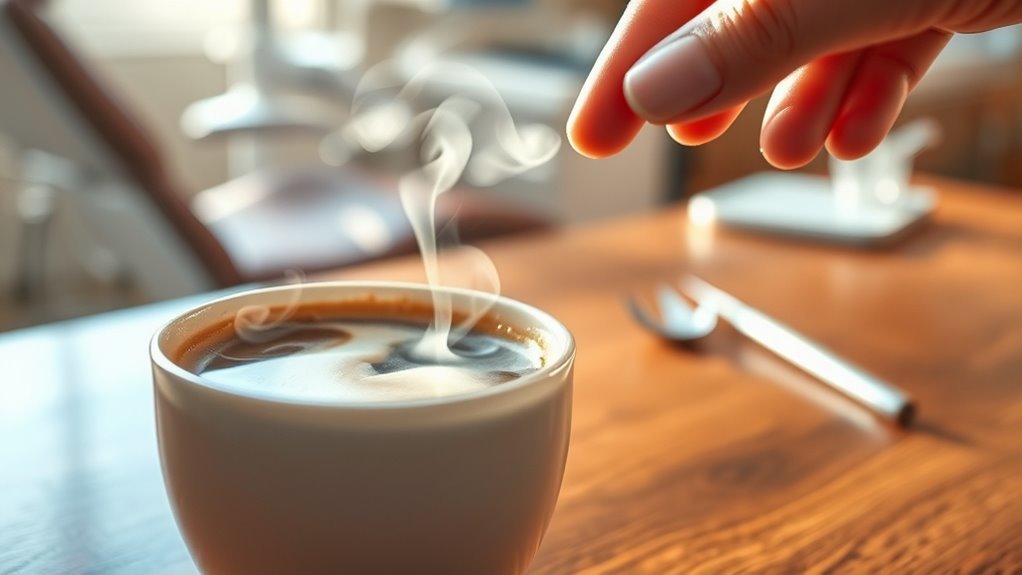
After a dental filling, your mouth may be more sensitive to temperature changes. Consuming hot beverages too soon can increase this sensitivity and lead to discomfort. It’s crucial to wait a while before enjoying that cup of coffee to allow your mouth to adjust.
Temperature Sensitivity After Procedure
Although many people enjoy a hot cup of coffee, it’s important to reflect on the effects of temperature sensitivity on your mouth following a dental filling. After the procedure, your teeth might experience heightened dental sensitivity, leading to a strong temperature reaction to hot beverages. This sensitivity can be uncomfortable and may persist for a few days.
Here are some tips to take into account:
- Wait before consuming hot drinks: Give your mouth time to heal.
- Opt for lukewarm beverages: This can help minimize discomfort.
- Monitor your symptoms: If sensitivity worsens, consult your dentist.
Risk of Sensitivity Increase
While enjoying a hot beverage may seem comforting, it can greatly heighten sensitivity in your mouth after a dental filling. When you consume hot drinks, the heat can aggravate nerve endings, leading to increased discomfort. Effective sensitivity management is essential during this recovery period in your dental care routine.
| Potential Effects | Recommendations |
|---|---|
| Increased Sensitivity | Avoid hot beverages initially |
| Discomfort while eating | Stick to lukewarm options |
| Prolonged recovery time | Consult your dentist if severe |
Being mindful of your beverage choices can considerably impact your comfort. Prioritize your dental care by allowing time for your fillings to set before indulging in hot drinks.
Timing for Hot Beverages
If you’ve recently had a dental filling, it’s important to be mindful of when you consume hot beverages. Hot drinks can exacerbate sensitivity and discomfort in your mouth, especially right after your procedure. It’s best to wait at least 24 hours before indulging in your favorite coffee or tea.
Here are some tips to keep in mind:
- Test Temperature: Verify your beverage isn’t too hot; lukewarm is safer.
- Explore Brewing Methods: Try cold brews or French press to minimize heat exposure.
- Caffeine Alternatives: Think about herbal teas or decaffeinated options to reduce irritation.
Timing: When Can You Resume Drinking Coffee?
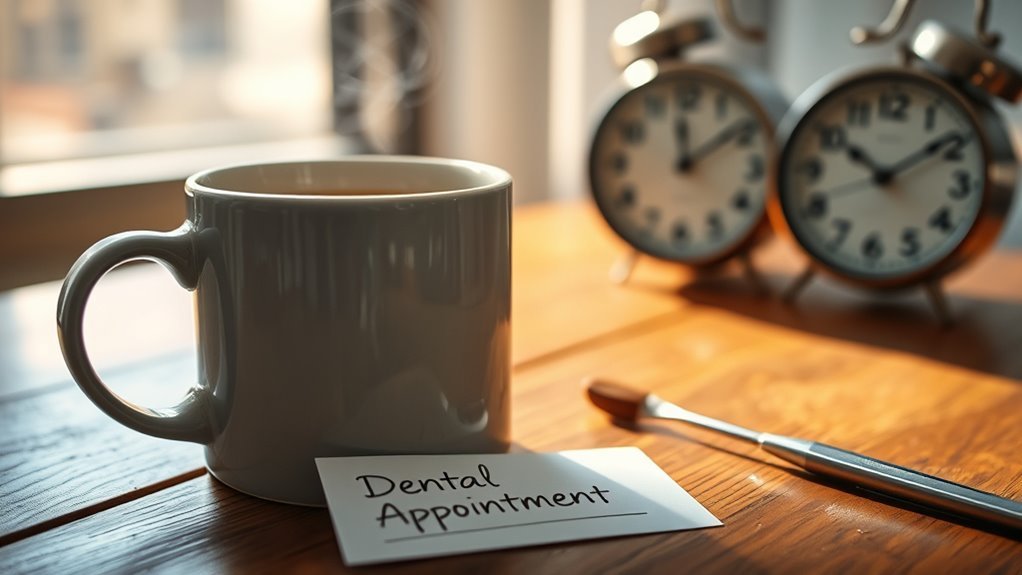
Once your dental filling procedure is complete, you might wonder when it’s safe to resume drinking coffee. Generally, it’s best to wait at least 24 hours before enjoying your favorite brew. This waiting period allows the filling material to set properly, ensuring durability. Additionally, consider the temperature of your beverage; hot coffee can irritate sensitive areas in your mouth. If you’re impatient for a warm drink sooner, coffee alternatives like herbal teas or warm water with lemon can be great options. These beverages provide comfort without the risks associated with hot coffee. Ultimately, listen to your body, and if you feel any discomfort, it’s wise to postpone your coffee indulgence until you’re sure it’s safe.
Potential Sensitivity After a Filling
After getting a filling, you may experience some sensitivity in the treated area, which is quite common. This filling sensitivity can manifest as temporary dental discomfort, especially when consuming hot, cold, or sweet foods and beverages. Here are a few things to keep in mind:
After a filling, expect some common sensitivity, especially with hot, cold, or sweet foods.
- Sensitivity can last a few days post-procedure.
- Over-the-counter pain relief can help manage discomfort.
- If sensitivity persists beyond a week, consult your dentist.
Understanding these aspects can help you navigate the healing process more comfortably. While it might be tempting to indulge in your favorite coffee right away, it’s important to monitor how your mouth feels and respond accordingly to any signs of discomfort. Your well-being comes first!
Alternatives to Coffee Post-Procedure

While enjoying a steaming cup of coffee might be tempting after your dental filling, opting for alternatives can be a wise choice during the initial healing period. There are several coffee substitutes to evaluate that won’t interfere with your recovery. Herbal teas, for instance, are excellent caffeine alternatives, offering soothing flavors without the potential irritation coffee can cause. You might also enjoy a warm cup of decaffeinated tea or chicory root coffee, which mimics the taste of coffee without the caffeine. Additionally, think about trying golden milk, made with turmeric, or a smooth hot chocolate made from cocoa. These options can keep you satisfied while ensuring your mouth heals comfortably. Remember, your health should always come first!
Signs of Complications to Watch For
Although most people experience a smooth recovery following a dental filling, it’s important to be vigilant for signs of complications. If you notice any of the following symptoms, reach out to your dentist promptly:
- Persistent pain: If pain management doesn’t relieve your discomfort after a few days, it may indicate an issue.
- Swelling or redness: Inflammation around the filling site could signal an infection or allergic reaction.
- Changes in bite: If your bite feels uneven or uncomfortable, it may require adjustment to guarantee proper alignment.
Maintaining good oral hygiene is essential during recovery, as it helps prevent complications. Trust your instincts; if something feels off, don’t hesitate to consult your dental professional.
Tips for Enjoying Coffee Safely After a Filling
Wondering how to enjoy your coffee safely after getting a dental filling? First, give your mouth some time to heal; wait at least 24 hours before indulging in hot beverages. When you do dive back in, consider starting with lukewarm coffee to avoid discomfort. If you’re sensitive to caffeine effects, think about coffee alternatives like herbal tea or decaf options, which can still provide a comforting ritual without the jitters. Always listen to your body—if you experience any pain or sensitivity, it might be best to take a step back. Staying hydrated is essential, so balance your coffee intake with plenty of water. By following these tips, you can savor your coffee while ensuring a smooth recovery.
Frequently Asked Questions
Can I Drink Iced Coffee After a Dental Filling?
After a dental filling, you might wonder if you can enjoy iced coffee. While it’s generally safe to drink iced coffee, you should consider your dental health first. If your filling is still sensitive, the cold temperature could cause discomfort. It’s best to wait for a few hours or until any numbness wears off. Always listen to your dentist’s advice regarding your specific situation to guarantee you’re protecting your oral health.
Will Coffee Affect the Color of My Filling?
Coffee can indeed affect the color of your filling, especially if it’s made from composite resin materials. These materials can be susceptible to staining agents found in coffee. Over time, regular consumption might lead to discoloration, which can alter the appearance of your filling. If you’re concerned about maintaining the aesthetic of your dental work, consider limiting coffee intake or rinsing your mouth with water afterward to minimize potential staining.
Can Caffeine Worsen Dental Pain Post-Filling?
Imagine a storm brewing within, where caffeine acts as both a catalyst and a foe. If you’re sensitive to caffeine, it could amplify any discomfort you’re feeling post-filling. While it might seem appealing for pain management, caffeine can lead to increased tension and heightened sensitivity in your teeth. It’s wise to tread carefully, as finding balance is key to your comfort and recovery during this healing process. Prioritize your well-being.
How Long Should I Avoid Coffee After a Filling?
After a filling, it’s wise to wait at least 24 hours before drinking coffee. This helps with pain management, as caffeine can sometimes intensify sensitivity. Prioritize your dental hygiene during this time; avoiding hot beverages can prevent discomfort and allow your filling to settle properly. By giving your mouth a chance to heal, you’re ensuring a smoother recovery and protecting your investment in your dental health.
Are There Any Long-Term Effects of Drinking Coffee After Fillings?
Drinking coffee after getting fillings can lead to some long-term effects, particularly if you’ve got sensitivity issues. Depending on the filling materials used, hot beverages might irritate your teeth, causing discomfort. While many people enjoy coffee, it’s wise to monitor how your teeth react. If you experience increased sensitivity or pain, it’s a good idea to consult your dentist for tailored advice. Keeping an eye on your oral health is essential for lasting comfort.
